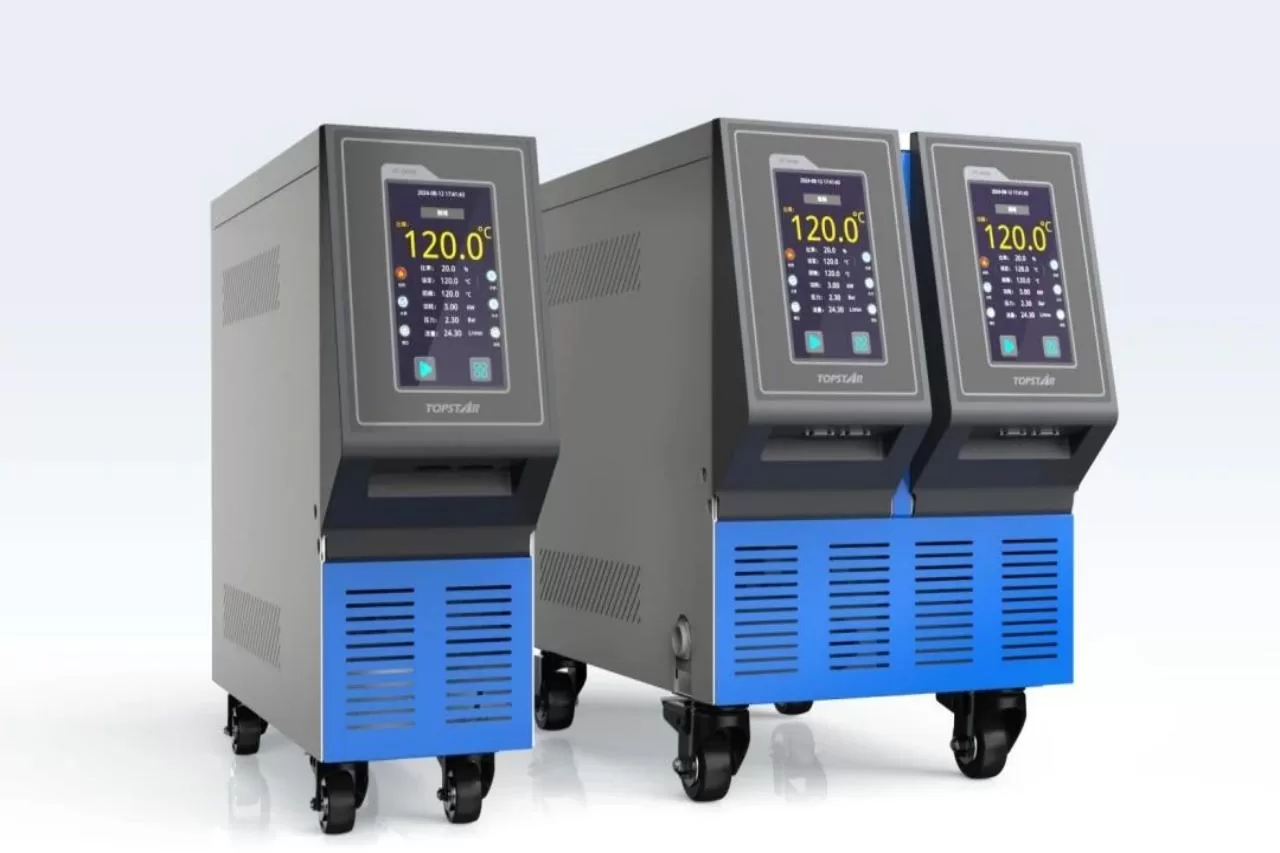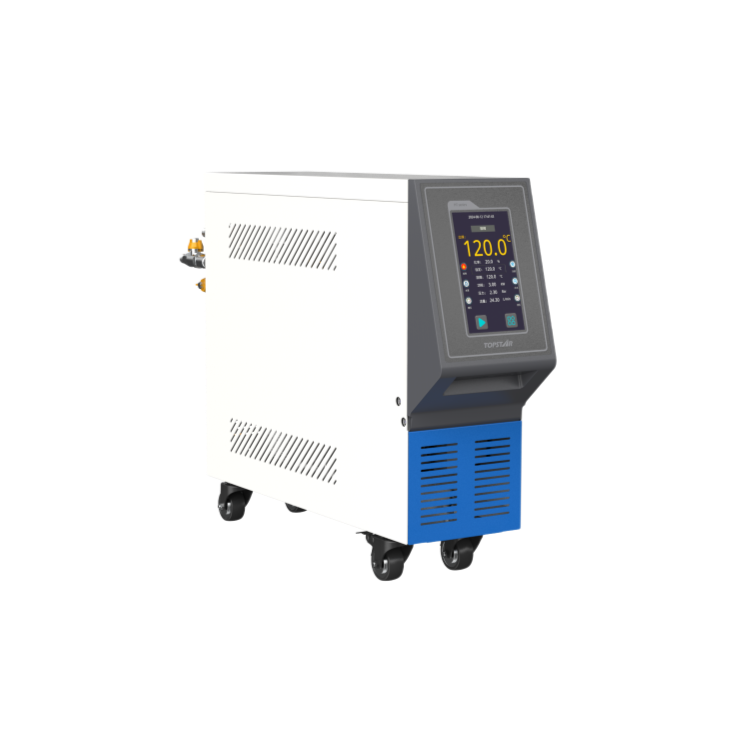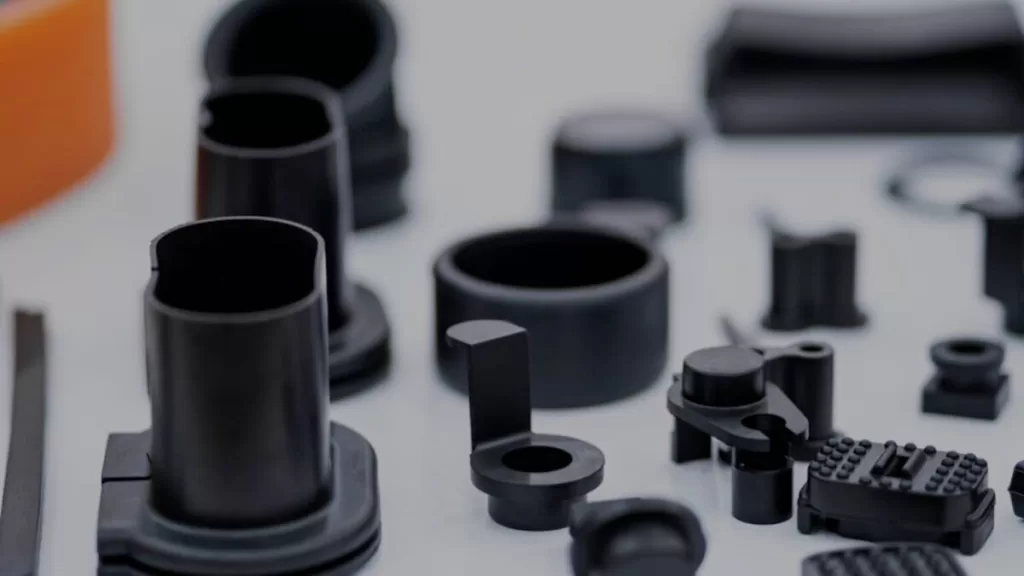120°C mould temperature controller: Which industries are suitable for 120°C
2025/10/17 By le zhan

One customer we worked with told us they were previously rejecting 15% of their thick-walled battery casing batches due to warpage. This issue was resolved after they switched to a Topstar 120°C mould temperature controller. Now, they’ve achieved a 98% yield and reduced cycle time by 10%. In injection moulding, a deviation of just 0.5°C from the target mould temperature can increase the defect rate of thick-walled plastic parts by 8%. For users considering a mould temperature controller, the 120°C range is a standard: high enough to ensure proper material flow in thick-walled parts, low enough to avoid thermal degradation, and accurate enough to meet stringent industry standards.
Why choose a 120°C mould temperature controller?
Mould temperature controller are used to regulate the temperature of injection moulds to ensure consistent part quality. 120°C mould temperature controllers are suitable for applications requiring medium temperatures (not high-temperature oil-based systems). Topstar’s 120°C mould temperature controller is water-based, meaning it uses water as a heat transfer medium, which is more efficient and safer than oil for many industries. Key features set it apart from standard mould temperature controllers:
1% Accuracy Pressure Sensor: Adjusts the upper temperature limit based on the incoming water pressure, ensuring proper operation even in factories with fluctuating water pressure.
20mm Diameter Cooling Solenoid Valve: Dissipates heat faster than smaller-diameter solenoid valves, reducing cooling time for thick parts by up to 12%.
PID Temperature Control Algorithm: Improves temperature control efficiency by 10% and maintains temperature differentials within ±0.1°C, significantly lower than the ±0.5°C average of basic controllers.
These features are more than just specifications; they are solutions that aid production. For example, the pressure sensor prevents the controller from shutting down during periods of low pressure, while the PID algorithm ensures that every part in a batch has an identical temperature history, eliminating both “good” and “bad” parts from the same run.

What industries are the 120°C mould temperature controllers suitable for?
120°C mould temperature controllers are a perfect match for the automotive industry, especially for thick-walled parts like engine covers and housings. Here’s why:
Thick-Wall Material Flow: Automotive-grade plastics (e.g., PP+GF, ABS) require a mould temperature of 120°C to flow evenly into thick-walled parts. Lower mould temperatures result in incomplete filling; higher mould temperatures can cause material degradation.
Preventing Warpage: Uneven cooling of thick-walled parts can lead to warpage, a costly defect for safety-critical components. Topstar’s 120°C mould temperature controller utilises a 20mm cooling solenoid valve to accelerate uniform cooling, while a PID algorithm maintains temperature stability, reducing warpage by 80%.
Productivity: Most automakers have long production runs, resulting in costly downtime. A pressure sensor with 1% accuracy ensures the controller will not stop operating if water pressure drops. Switching to Topstar’s 120°C mould temperature controller has resulted in a 3% increase in uptime.
Many automotive customers have commented, “We used to spend two hours per shift manually adjusting the temperature. Now, the PID system does it automatically, and our scrap rate has dropped from 12% to 1%.” This represents an upgrade in safety and efficiency for the automotive industry.
High flow and high pressure are key to thick-walled automotive parts
Thick-walled automotive parts, typically 8-20 mm thick, require robust heat dissipation to avoid defects such as sink marks, warping, and internal stresses. Conventional water-based temperature controllers often fall short in this regard. Their low flow rate (≤15 litres/minute) and low pressure make it difficult to ensure uniform cooling water flow through the deep and complex cooling channels of automotive moulds. Topstar’s 120°C temperature controllers address these issues with their high flow rate and high head. For example, for a 12 mm thick engine hood mold with four internal cooling channels, a standard temperature controller takes 18 minutes to cool the part to the demolding temperature (60°C), resulting in uneven shrinkage. The high flow rate of the 120°C mold temperature controller circulates water more quickly through the channels, reducing cooling time to 12 minutes while ensuring that every thick-walled part cools at the same rate.

20mm Cooling Solenoid Valve for Faster Cooling
The 20mm diameter cooling solenoid valve in the 120°C water-type mould temperature controller is designed explicitly for thick-walled automotive parts. It outperforms the 15mm valves commonly found in most standard mould temperature controllers. So what are the benefits of an extra 5mm of valve diameter?
Faster heat dissipation: The larger valve diameter allows more cooling water to enter the mould channels at once, accelerating heat dissipation. For a 15mm thick battery housing part, this can reduce the peak temperature from 105°C to 90°C in just 5 minutes, compared to 8 minutes with a 15mm valve.
Lower, stable control temperature: Thick-walled automotive parts typically require demolding at 55-65°C to prevent warping. The 20mm valve maintains a lower temperature without the need for “circulation,” thus avoiding temperature spikes.
Reduced Valve Wear: Larger valves can easily handle higher flow rates, extending their service life to over 30,000 cycles, critical for 24/7 automotive production lines.
PID control improves efficiency by 10% and achieves an accuracy of ±0.1°C.
Thick-walled automotive parts are particularly vulnerable to temperature fluctuations. Even a 0.5°C mould temperature fluctuation can cause a thick-walled part to fail quality inspection. Topstar’s 120°C mould temperature controller uses a PID temperature control algorithm to eliminate this risk, delivering two key advantages for automotive production:
10% Improved Control Efficiency: The PID algorithm adjusts water flow and heating in real time based on the deviation of the mould temperature from the target temperature. Unlike on/off controllers, PID fine-tunes output to maintain mould temperature control stability, reducing energy consumption by 10% and reducing cycle time fluctuations.
±0.1°C Temperature Fluctuation: This accuracy is unheard of in other mould temperature controllers. For a 10mm thick door panel reinforcement, this means every part cools to the same temperature, ensuring consistent dimensional accuracy.
In a real-world example, a global automotive Tier 1 supplier installed 15 Topstar units on its production line. After adopting a 120°C mould temperature controller, their yield rate jumped from 78% to 92%. “The PID algorithm keeps the mould temperature stable,” said their production manager. “We used to reject 22% of parts due to warpage, but now it’s less than 8%, and we’re able to ship more parts on time.”
The best mould temperature solution for thick-walled automotive products
For automotive manufacturers struggling with low yields, long cycle times, or temperature-related defects in thick-walled parts, Topstar’s 120°C mould temperature controller with high flow rate/large head, 20mm cooling solenoid valve, PID algorithm (10% efficiency improvement, ±0.1°C accuracy), and pressure sensor addresses all key pain points of thick-wall automotive moulding. This helps the automotive industry shorten cycle times, increase yields, and reduce interruptions.
TRENDING POSTS
- TOPSTAR Global Open Day 2025: Humanoid Robot Debuts, Pioneering a New Decade of Intelligent Manufacturing 2025/10/17
- Topstar Showcases TE II Electric Injection Molding Machines at InterPlas Thailand 2025 2025/10/17
- Topstar Expands Its Ecosystem Partnerships to Drive Smart Manufacturing Innovation 2025/10/17
- What factors can cause delays in the injection molding process of plastic molding machine? 2025/10/17
HOT TOPIC
- .ervo motor-driven linear robots
- •
- 1.0 guangdong topstar technology co. ltd
- 1.0 topstar china
- 1.0 topstar robot
- 11
- 160℃ mold temperature controller
- 170 ton injection molding machine
- 2
- 21
- 220-ton injection molding machine
- 23
- 3 axis robot
- 3 axis robots
- 3 in 1 Compact Dehumidifying Dryer
- 3-axis robot
- 3-axis robots
- 39
- 41
- 460T injection molding machine
- 5-axis CNC machine
- 62
- 90 ton injection molding machine
- accuracy
- Air Chillers
- all electric injection molding machine
- all electric injection molding machines
- all-electric injection molding machine
- All-electric injection molding machines
- and overall production quality. Therefore
- AP-RubberPlas
- automated injection molding machine
- Automation changed engineering
- automation of injection molding robots
- automotive parts injection molding
- auxiliary machine
- Bench Injection Molding Machine
- Cabinet dryer manufacturers
- Cabinet dryers
- chiller
- CNC Drilling Machine
- CNC Drilling Machines
- cnc engraving machine manufacturer
- cnc laser cutting machine manufacturer
- CNC machine
- CNC Machine Center
- CNC Machine for Sale
- CNC Machine Manufacturing
- CNC Machine Tool
- CNC machine tool product
- CNC Machining Center
- CNC wood carving machine
- Cooling system
- Cross-Walking Single Axis Servo Cylinder Robot
- Cross-Walking Single-Axis Servo Cylinder Robot
- Cross-Walking Three-Axis/Five-Axis Servo Driven Robot
- cross-walking three-axis/five-axis servo-driven robot
- Dehumidifier Dryer
- Dehumidifying Dryer
- delta parallel robot
- Desktop Injection Molding Machine
- Desktop injection molding machines
- Desktop Molding Machine
- desktop plastic injection machine
- Desktop Plastic Injection Molding Machine
- Digital Transformation
- direct clamp injection molding machine
- Direct clamp injection molding machines
- Dosing & mixing system
- Drilling Centers
- Drying and dehumidification system
- drying and dehumidifying equipment
- Drying and Dehumidifying System
- drying system
- effective and efficient. Cabinet dryers are also used in other industries where large quantities of material need to be dried
- efficient injection molding machine
- elbow hydraulic injection molding machines
- electric injection molding machine
- electric injection molding machines
- energy-efficient injection molding robot
- energy-efficient water chiller
- energy-efficient water chillers
- energy-saving injection molding machine
- etc. Among injection molding robots
- exhibition
- features of CNC machine
- Feeding And Conveying System
- Five Axis Machine Center
- Flexible Production Line
- Fully automatic injection molding machine
- Gathering Topstar
- giant injection molding machine
- GMU-600 5-Axis Machining Center
- Granulating & Recycling System
- Heavy duty injection molding machine
- High-precision electric molding machines
- high-precision plastic molding machines
- high-speed all electric injection molding machine
- high-speed electric injection molding machine
- High-Speed Packaging Injection Molding
- Honeycomb rotor dehumidifier
- horizontal injection molding machine
- Horizontal Injection Molding Machines
- Horizontal Injection Moulding Machine
- Horizontal Mixer manufacturer
- How The CNC Machine Works
- hybrid injection molding machine
- hydraulic injection molding machine
- Hydraulic Injection Molding Machines
- in this article
- Industrial AI
- Industrial Automation
- Industrial robot
- Industrial Robot Chinese brand
- industrial robot parts
- industrial robot supplier
- Industrial robots
- Industry Chain
- Injection Manipulator
- injection manipulator robot
- injection mold machines
- Injection molding
- Injection molding automation
- Injection Molding Automation Solution
- injection molding dryer
- Injection molding equipment
- injection molding hopper dryer
- Injection molding machine
- injection molding machine brand
- Injection Molding Machine Factory
- Injection Molding Machine Manufacture
- Injection molding machine manufacturer
- injection molding machine manufacturers
- Injection molding machine procurement
- injection molding machine robotic arm
- injection molding machine with a robot
- Injection molding machines
- injection molding material dehumidifying
- injection molding plant
- injection molding process
- Injection Molding Robot
- injection molding robot arm
- Injection molding robot automation
- Injection molding robotic arm
- injection molding robots
- Injection moulding machine
- injection moulding machines
- Injection Moulding Robots
- Injection Robot
- Injection robot arm
- Injection robot manufacturer
- Injection robot wholesale
- injection robots
- Intelligent Factory
- intelligent injection molding machines
- Intelligent Manufacturing
- intelligent mold temperature
- intelligent mold temperature controller
- Intelligent mould temperature controller
- InterPlas Thailand 2025
- Introducing Injection Robot
- It is the best choice for drying large quantities of material at once. Cabinetmakers use these machines because they are fast
- Large flow water type mold temperature controller
- large injection molding machine
- large injection molding machines
- Learn what industrial automation and robotics is
- linear robot
- linear robots
- low speed sound-proof granulator
- machine plastic molding
- make sure to add some! Improvements (2) Keyphrase in introduction: Your keyphrase or its synonyms appear in the first paragraph of the copy
- manipulator machine
- manufacturing
- Manufacturing Innovation
- medical grade injection molding machines
- Medical Injection Molding
- medical injection molding machine
- medical injection molding machines
- micro injection molding machine
- middle speed granulator
- Mini CNC machine manufacturers.
- mobile cover making machine
- Mold Temperature Control System
- mold temperature controller
- mold temperature controllers
- molding machine
- molding material Dehumidifying System
- mould temperature control system
- mould temperature controller
- mould temperature controllers
- New electric injection molding machine
- nitrogen dryer manufacturer
- nitrogen dryer system manufacturer
- Oil type mold temperature controller
- Oil type mold temperature controllers
- open day
- optical component injection molding
- Outbound links: No outbound links appear in this page. Add some! Images: No images appear on this page. Add some! Internal links: No internal links appear in this page
- packaging injection molding
- Packaging Solutions
- PET Preform injection molding
- phone case maker machine
- phone case making machine
- phone cover making machine
- plastic bottle making machine
- plastic bottle manufacturing
- plastic bucket making machine
- plastic bucket manufacturing
- Plastic chair making machine
- plastic forming equipment
- plastic hopper dryer
- plastic injection machine
- plastic injection machines
- plastic injection molding
- Plastic injection molding equipment
- Plastic injection molding machine
- Plastic Injection Molding Machines
- plastic injection moulding machine
- plastic injection moulding machines
- plastic injection robot
- plastic molding
- Plastic Molding Industry
- Plastic Molding machine
- plastic molding machine 1
- Plastic Molding Machines
- plastic molding press
- plastic moulding machine
- plastic phone case making machine
- plastic-molding machine
- powerful granulator
- Powerful Type Sound-Proof Granulator
- precision injection molding
- precision injection molding machines
- production of plastic seats
- pure water mould temperature controller
- Robot injection molding
- robot injection molding machine
- robot manufacturing companies
- Robotic arm for injection molding machine
- robotic injection molding machines
- robotics in injection molding
- SCARA robot
- SCARA robots
- Service-oriented manufacturing
- Servo Cylinder Robot
- servo driven robot
- Servo Driven Robots
- servo injection molding machine
- servo injection robots
- servo motor-driven linear robots
- servo-driven 3-axis robot
- Servo-Driven Robot
- Setup of injection machine
- Silicone Injection Molding Machine
- six-axis industrial robot
- Smart Manufacturing
- Stainless Hopper Dryer
- Stainless Hopper Dryers
- star club
- swing arm robot
- take-out robot
- take-out robots
- Thailand 4.0
- the choice between servo-driven robots and hydraulic robots will have a certain impact on efficiency
- the most popular injection molding machine
- the type of injection molding robot
- TIC2000 Control System
- TMII injection molding machine
- toggle clamp injection molding machine
- Toggle Hydraulic Injection Molding Machines
- toggle injection molding machine
- Top 10 brands of injection robots
- Topstar
- Topstar Electric Injection Molding Machine InterPlas Thailand 2025 Smart Manufacturing Thailand 4.0
- Topstar Engineering
- Topstar Industrial Robots
- Topstar injection molding intelligent
- Topstar Scara Robots
- Useful Injection molding machine
- Vertical machining centers
- volumetric type blender
- water chiller
- water chillers
- water distributor
- water type mold temperature controller
- Water Type MoldTemperature Controller
- Water-Type Mould Temperature Controllers
- We often face choices when performing injection molding. We will choose the type of injection molding machine
- wholesale of injection molding machines
- x carve CNC
- 热门查询 点击次数 展示 排名 topstar
